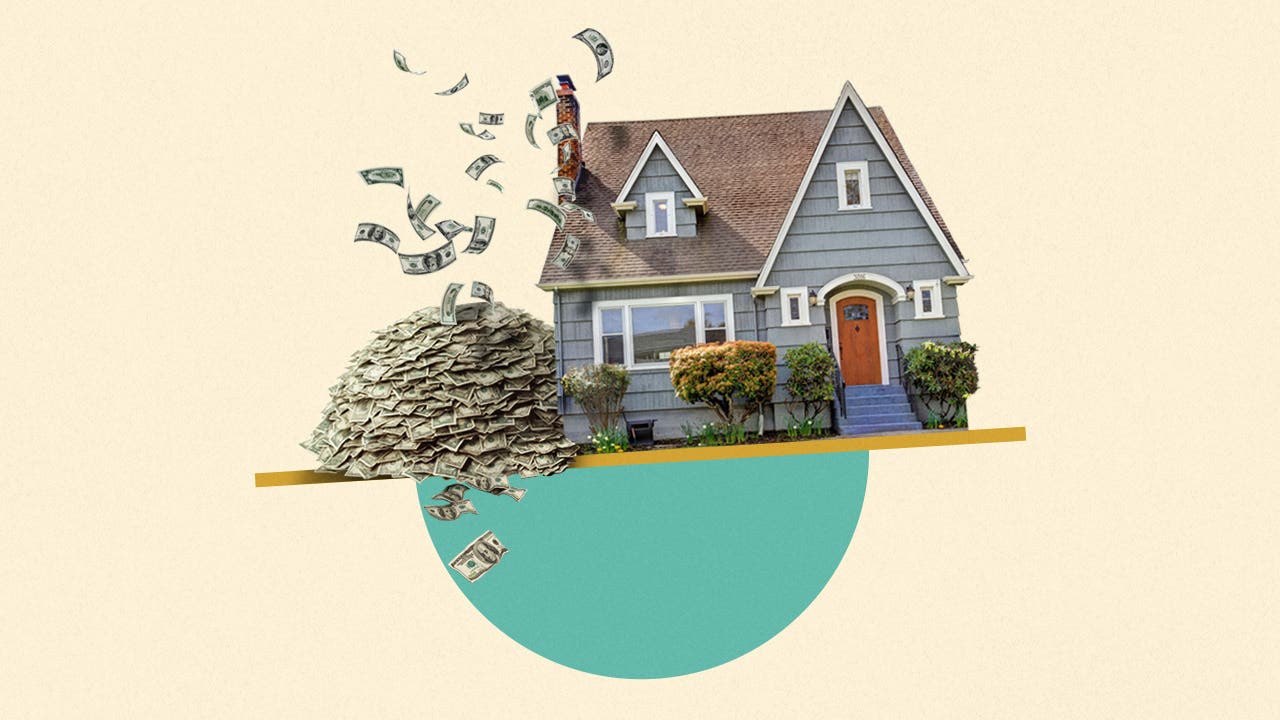How does mortgage interest work? A guide to your loan’s cost

The Bankrate promise
At Bankrate we strive to help you make smarter financial decisions. While we adhere to strict , this post may contain references to products from our partners. Here's an explanation for .
Key takeaways
- When you take out a mortgage, you must repay the total amount you borrowed – plus interest calculated on that amount.
- Mortgage interest is the price that you pay for borrowing money from a lender.
- The amount you'll pay in mortgage interest varies based on your credit score, down payment size, economic conditions and other factors.
The interest rate on your mortgage determines what you’ll pay to borrow money from a lender, expressed as a percentage. Understanding mortgage rates is a critical step in the homebuying process, because it helps you figure out exactly how much your mortgage will cost you in the long run.
In general, shorter-term loans, like a 15-year mortgage, come with a lower interest rate, but have higher monthly payments. Longer-term loans, such as 30-year mortgages, come with a higher rate, but lower monthly payments. This is in part because you’re repaying the balance back over a longer period of time. Shorter-term loans typically cost less in total interest.
So, how do mortgage interest rates work? They’re determined by many factors, including your credit score. If you have a higher score, you’re much more likely to get a favorable rate. The lender’s approach to pricing and broader financial factors like the 10-Year Treasury yield and inflation also influence mortgage rates.
How does mortgage interest work?
Your mortgage interest is a percentage of your balance. As you repay your mortgage, you’ll make monthly payments based on your loan’s amortization schedule. As your loan matures, more of your payment goes toward the principal, or the amount you borrowed. Initially, more of your payment goes to interest.
Let’s say you have a 30-year fixed-rate mortgage with a balance of $300,000 and an interest rate of 6 percent.
Your monthly mortgage payment (principal and interest) would remain $1,798 throughout the 30-year term, but for your first payment, $298 of that would be applied to the principal and $1,500 would be applied to interest. Fast-forward to halfway through your loan term, and about $716 of your payment would be applied to the principal and roughly $1,080 would be applied to the interest. You’ll continue to pay more toward principal, and less toward interest, until the loan is fully repaid.
Mortgage interest rate example
Say you’re buying a home for $390,000 with 20 percent down. With a 30-year mortgage for $312,000 at a fixed rate of 6.75 percent, your monthly payment would be $2,024. This sum excludes homeowners insurance, property taxes and any HOA fees, which are often included in monthly payments as well.
Using Bankrate’s amortization calculator, here’s how your amortization schedule would look, assuming you took out the loan this year:
| Date | Monthly payment | Principal | Interest | Balance |
|---|---|---|---|---|
| November 2023 | $2,024 | $268.63 | $1,755.00 | $311,731.37 |
| December 2023 | $2,024 | $270.14 | $1,753.49 | $311,461.24 |
| January 2024 | $2,024 | $271.66 | $1,751.97 | $311,189.58 |
| February 2024 | $2,024 | $273.18 | $1,750.44 | $310,916.40 |
| March 2024 | $2,024 | $274.72 | $1,748.90 | $310,641.67 |
| April 2024 | $2,024 | $276.27 | $1,747.36 | $310,365.41 |
| May 2024 | $2,024 | $277.82 | $1,745.81 | $310,087.59 |
| June 2024 | $2,024 | $279.38 | $1,744.24 | $309,808.20 |
| July 2024 | $2,024 | $280.95 | $1,742.67 | $309,527.25 |
| August 2024 | $2,024 | $282.54 | $1,741.09 | $309,244.71 |
| September 2024 | $2,024 | $284.12 | $1,739.50 | $308,960.59 |
| October 2024 | $2,024 | $285.72 | $1,737.90 | $308,674.87 |
Fixed-rate interest vs. adjustable-rate interest
When you take out a mortgage, you might need to decide whether you prefer a fixed or adjustable interest rate.
With a fixed-rate mortgage, your interest rate won’t change over the life of the loan. Your monthly payment won’t change, either. For instance, if you borrowed $300,000 at a fixed rate of 7 percent, you would pay around $1,996 per month for the entirety of your 30-year loan.
However, if you have an adjustable-rate mortgage (ARM), your rate can change during your repayment period. Your ARM may come with a low introductory rate for the first several years of your loan, but after that, it can go up or down – which can increase or decrease your monthly payment.
APR vs. interest rate
The interest rate on your mortgage only accounts for the cost of borrowing money — it’s a percentage of the total size of your loan.
The APR (short for annual percentage rate), on the other hand, accounts for both your mortgage interest rate and other costs, including lender fees and discount points. APR is also expressed as a percentage, but because it includes these other charges, it is always higher than the interest rate.
In effect, the APR is your true interest rate — the actual, annualized cost you pay for your loan.
By law, lenders have to disclose the APR for a given loan so that borrowers have accurate cost information upfront. APRs differ from lender to lender, so it’s important to ask what the APR includes. Some APRs don’t include credit report or appraisal fees, for instance. Keep in mind that you can try to negotiate down some fees, especially if you’re a well-qualified borrower.
How to get the best mortgage rate
For the best chance at the lowest mortgage rate, follow these tips:
- Improve your credit score – Lenders offer their lowest rates to those with strong credit. Well ahead of applying for a mortgage, work to boost or maintain your score by paying your bills on time and lowering your credit utilization ratio, the ratio of your credit balance to your credit limit.
- Build a record of your work history – Lenders generally look favorably on borrowers with at least two years of consistent employment. If your work history has significant gaps or you’re self-employed, you might have to provide more paperwork to get approved for the best possible rate.
- Save more for a down payment – Putting more money down upfront can help you secure a lower rate. One way to grow your savings is to automatically set aside a portion of your income into a savings account. You can also look into down payment assistance programs.
- Compare rates – Comparing offers to find the lowest mortgage rate can save you significantly over the course of a 30-year loan, one Freddie Mac study found.
- Consider a low-credit mortgage – If your credit score isn’t as high as you’d like it to be, consider getting an FHA loan. FHA loans can sometimes have a lower interest rate, by about a half a point or more, compared to a conventional loan.
- Work with a mortgage broker – A broker can help find you the best deal and negotiate a lower rate, and many don’t charge any fees. Be sure to look for a broker who has experience with the type of loan you’re after.
- Pay points – If you expect to stay in the home long-term and won’t refinance for at least five years, you can choose to pay an additional fee, known as a point, to trim your interest rate. Each point typically costs 1 percent of the loan amount and reduces your rate by 0.25 percentage points.
Mortgage interest rate FAQs
-
Mortgage rates fluctuate frequently, so what’s considered “good” changes over time. While you can compare mortgage rates online, you’ll also need to compare quotes specifically tailored to your situation in order to find a good rate. One rule of thumb is to get at least three offers so you know what rates are available based on your credit and financial profile. Be sure to give each lender the same information to go on, and try to get quotes within the same day, if possible. If you find an affordable rate, consider locking it in.
-
When setting interest rates, lenders review several factors, including the performance of bonds, current economic conditions, inflation and Federal Reserve policies.
Your financial profile also plays a role. Lenders will consider personal factors like your credit score, loan-to-value (LTV) ratio and debt-to-income (DTI) ratio to help determine your rate. -
Mortgage rates change constantly. If you find a competitive rate with a lender you like, it might be worth locking it in before it increases.
-
Each tax year, borrowers can deduct interest paid on the first $750,000 of mortgage debt (or the first $375,000 if married filing separately). If you bought your home before Dec. 16, 2017, you can deduct the interest on the first $1 million (or first $500,000 if married filing separately). Your mortgage falls into this latter category if you were under contract on the home before Dec. 15, 2017, set to close before Jan. 1, 2018 and completed the purchase prior to April 1, 2018.
Before you decide to itemize deductions, however, consult with an accountant or tax professional.
Additional reporting by Taylor Freitas
Related Articles



How to get the best mortgage rate: A guide to finding the lowest rate
